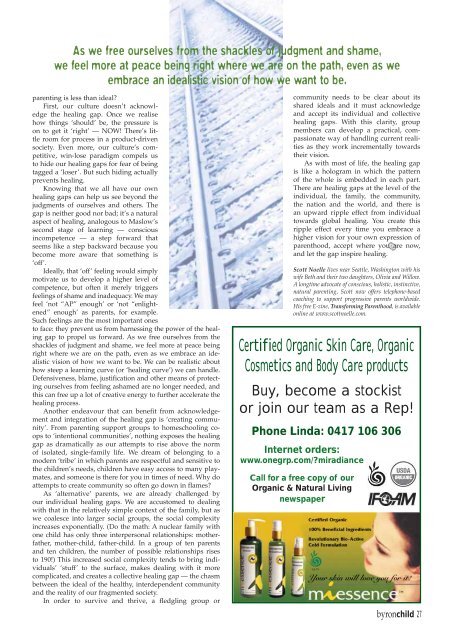byronchild - logo
byronchild - logo
byronchild - logo
Create successful ePaper yourself
Turn your PDF publications into a flip-book with our unique Google optimized e-Paper software.
As we free ourselves from the shackles of judgment and shame,<br />
we feel more at peace being right where we are on the path, even as we<br />
embrace an idealistic vision of how we want to be.<br />
parenting is less than ideal?<br />
First, our culture doesn’t acknowledge<br />
the healing gap. Once we realise<br />
how things ‘should’ be, the pressure is<br />
on to get it ‘right’ — NOW! There’s little<br />
room for process in a product-driven<br />
society. Even more, our culture’s competitive,<br />
win-lose paradigm compels us<br />
to hide our healing gaps for fear of being<br />
tagged a ‘loser’. But such hiding actually<br />
prevents healing.<br />
Knowing that we all have our own<br />
healing gaps can help us see beyond the<br />
judgments of ourselves and others. The<br />
gap is neither good nor bad; it’s a natural<br />
aspect of healing, ana<strong>logo</strong>us to Maslow’s<br />
second stage of learning — conscious<br />
incompetence — a step forward that<br />
seems like a step backward because you<br />
become more aware that something is<br />
‘off’.<br />
Ideally, that ‘off’ feeling would simply<br />
motivate us to develop a higher level of<br />
competence, but often it merely triggers<br />
feelings of shame and inadequacy. We may<br />
feel ‘not “AP” enough’ or ‘not “enlightened”<br />
enough’ as parents, for example.<br />
Such feelings are the most important ones<br />
to face: they prevent us from harnessing the power of the healing<br />
gap to propel us forward. As we free ourselves from the<br />
shackles of judgment and shame, we feel more at peace being<br />
right where we are on the path, even as we embrace an idealistic<br />
vision of how we want to be. We can be realistic about<br />
how steep a learning curve (or ‘healing curve’) we can handle.<br />
Defensiveness, blame, justification and other means of protecting<br />
ourselves from feeling ashamed are no longer needed, and<br />
this can free up a lot of creative energy to further accelerate the<br />
healing process.<br />
Another endeavour that can benefit from acknowledgement<br />
and integration of the healing gap is ‘creating community’.<br />
From parenting support groups to homeschooling coops<br />
to ‘intentional communities’, nothing exposes the healing<br />
gap as dramatically as our attempts to rise above the norm<br />
of isolated, single-family life. We dream of belonging to a<br />
modern ‘tribe’ in which parents are respectful and sensitive to<br />
the children’s needs, children have easy access to many playmates,<br />
and someone is there for you in times of need. Why do<br />
attempts to create community so often go down in flames?<br />
As ‘alternative’ parents, we are already challenged by<br />
our individual healing gaps. We are accustomed to dealing<br />
with that in the relatively simple context of the family, but as<br />
we coalesce into larger social groups, the social complexity<br />
increases exponentially. (Do the math: A nuclear family with<br />
one child has only three interpersonal relationships: motherfather,<br />
mother-child, father-child. In a group of ten parents<br />
and ten children, the number of possible relationships rises<br />
to 190!) This increased social complexity tends to bring individuals’<br />
‘stuff’ to the surface, makes dealing with it more<br />
complicated, and creates a collective healing gap — the chasm<br />
between the ideal of the healthy, interdependent community<br />
and the reality of our fragmented society.<br />
In order to survive and thrive, a fledgling group or<br />
community needs to be clear about its<br />
shared ideals and it must acknowledge<br />
and accept its individual and collective<br />
healing gaps. With this clarity, group<br />
members can develop a practical, compassionate<br />
way of handling current realities<br />
as they work incrementally towards<br />
their vision.<br />
As with most of life, the healing gap<br />
is like a hologram in which the pattern<br />
of the whole is embedded in each part.<br />
There are healing gaps at the level of the<br />
individual, the family, the community,<br />
the nation and the world, and there is<br />
an upward ripple effect from individual<br />
towards global healing. You create this<br />
ripple effect every time you embrace a<br />
higher vision for your own expression of<br />
parenthood, accept where you are now,<br />
and let the gap inspire healing.<br />
Scott Noelle lives near Seattle, Washington with his<br />
wife Beth and their two daughters, Olivia and Willow.<br />
A longtime advocate of conscious, holistic, instinctive,<br />
natural parenting, Scott now offers telephone-based<br />
coaching to support progressive parents worldwide.<br />
His free E-zine, Transforming Parenthood, is available<br />
online at www.scottnoelle.com.<br />
Certified Organic Skin Care, Organic<br />
Cosmetics and Body Care products<br />
Buy, become a stockist<br />
or join our team as a Rep!<br />
Phone Linda: 0417 106 306<br />
Internet orders:<br />
www.onegrp.com/?miradiance<br />
Call for a free copy of our<br />
Organic & Natural Living<br />
newspaper<br />
<strong>byronchild</strong> 27


